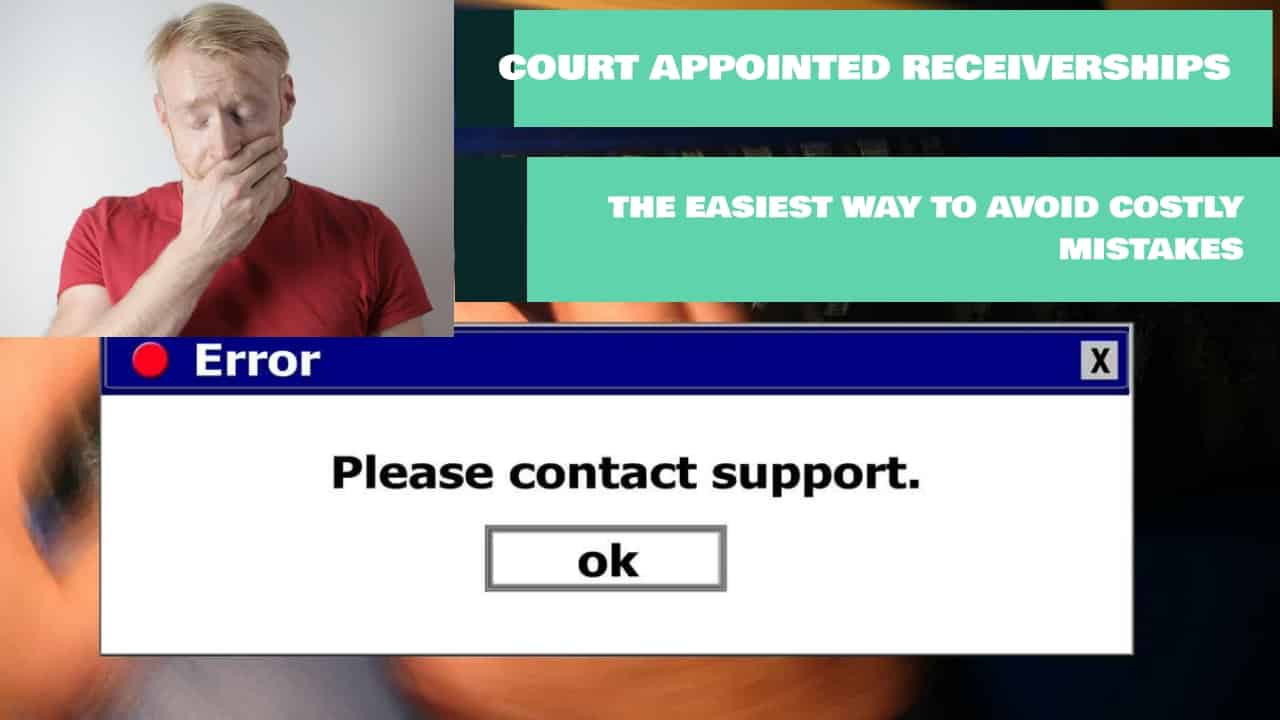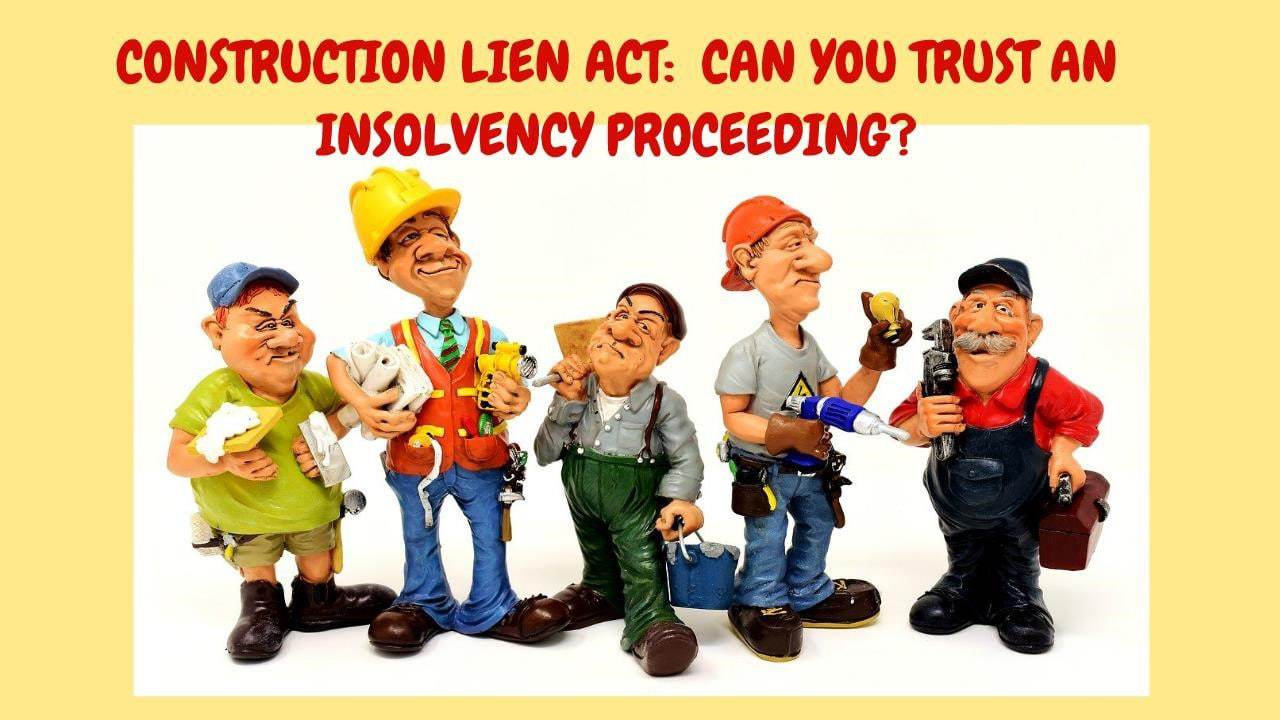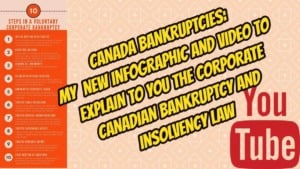
The Ira Smith Trustee Team is absolutely operational and Ira, in addition to Brandon Smith, is readily available for a telephone consultation or video meeting. We hope that you and your family are safe and healthy.
If you would prefer to listen to the audio version of this court appointed receiverships Brandon’s Blog, please scroll to the bottom and click play on the podcast.
Court appointed receiverships introduction
I have written several blogs before on receivership, be they court appointed receiverships or private appointments. The purpose of this blog is to discuss a recent court decision involving a big mistake made by a court-appointed receiver and why the court would not let them fix their error. That mistake cost them big time!
Some previous court appointed receiverships blogging
In reviewing the court case, three previous blogs of mine on court appointed receiverships came to mind:
- Courts of Justice Act: Court of Appeal For Ontario Creates New Rule?
- Licensed Insolvency Trustee Receiver Appointed By Court Errors To Avoid
- Top Court Appointed Receiver Secret: Details Matter
The first one dealt with certain procedural matters in court appointed receiverships when the receiver sells real estate.
The second blog dealt with factors a court-appointed receiver must disclose to the court in seeking court approval for a sale of assets.
The third one was about what happens when a court-appointed receiver applies to the court for some relief without knowing all the details of the story they are telling the court! That is very embarrassing for receivers in court appointed receiverships!
The recent case I will shortly speak about reminded me of these three previous blogs. You will see the connection very soon, I promise.
What happens when a company goes into receivership?
When the company enters into receivership, senior management and the Directors shed most of their authority for decision making. The Directors’ general company obligations of preserving corporate records remain, yet any type of decision-making regarding the running of the business or its assets have vanished.
That is now the role of the receiver. This is true for a privately appointed receiver but it is especially so in court-appointed receiverships. That is because the court is now supervising all the company’s affairs and assets through its court officer, the receiver.
Responsibilities concerning the business in a practical sense stop upon the receiver being appointed. Their recommendations and help are only needed if requested by the receiver. They definitely will not be paid for any kind of initiative unless the receiver concurs in writing to make funds available for them in return for their services.
What are the duties of a receiver?
The receiver’s first task is to take possession of and control all of the assets, properties and undertaking covered by the secured creditor’s security in a private receivership. In court appointed receiverships, the receiver’s powers and actions come from the authority given to it by way of the court order appointing the receiver.
The receiver needs to make a decision whether it can get a greater amount for the assets if it runs the business. Conversely, the receiver may choose that the danger of operating the business is not worth it in terms of any type of upside value that may be gained from running the business.
The receiver after that creates a strategy for the running or the shuttering of the business as well as for the eventual sale of the assets. The kind of receivership appointment and the nature of the business operations and assets will dictate what approach the receiver will take. In the meantime, the receiver must protect and conserve all the assets, including making sure there is sufficient insurance coverage in place.
In a private appointment, the receiver requires to obtain the authorization of the secured creditor who appointed the receiver prior to implementing its plan and taking actions concerning the running of the business and the sale of the assets. In court appointed receiverships, the receiver requires the approval of the court.
The Court appointment case
This court case dealt with some very unique issues. The receiver was originally appointed by the court under the Courts of Justice Act (Ontario) and the Bankruptcy and Insolvency Act (Canada). The receiver was making a motion for advice and directions about it wanting approval for its fees and disbursements since the last approval order. It also wanted approval to make an interim distribution.
That seems pretty routine. It was the receiver’s fifth report to the court. The motion was opposed by the company whose assets were seized in the receivership. There was only one problem that caused that party to oppose the receiver’s motion. However, it was a humungous problem this receiver caused itself.
The problem is that the receiver obtained approvals from the court based on the information contained in its fourth report to the court and now the receiver was asking for something different!
Court appointed receiverships: A brief history of this court-appointed receivership
The major secured creditor who made a secured loan against a real estate project under both mortgage security and a general security agreement began court proceedings by making an application to the Ontario Superior Court of Justice Commercial List for the court appointment of a receiver. On June 22, 2017, Justice Conway released an Order appointing the receiver in this matter (the Receiver).
The Order followed the model receivership order format and had the usual provisions. Specifically, it mentioned in paragraph 18 that “the Receiver’s Charge shall form a first charge in priority to all security interests, trusts, liens, charges and encumbrances, statutory or otherwise, in favour of any Person….”.
The Receiver performed its duties and filed reports with the court on a timely basis and received the necessary approvals along the way. So far so good with the first three court reports.
The fourth report was OK too
In November 2019 the Receiver brought a motion for Justice Dietrich to approve its Fourth Report and also its Supplementary Fourth Report. The same stakeholder currently opposing the Receiver’s motion for advice and directions also challenged certain of the Receiver’s recommendations contained in its Fourth Report.
It turns out that from the Receiver’s efforts and sale of the real property, there was not only enough money to pay out all the secured creditors, but there were funds left over. This is a very unusual situation. So the Receiver came to court. One of the approvals it was seeking was its proposal to pay the claims of the unsecured creditors. This company opposed that relief claiming the unsecured creditors were statute-barred. The reason the company opposed this is simple. Whatever the unsecured creditors are not entitled to would presumably be available to flow to the shareholders of the company.
Justice Dietrich looked for further written materials on this issue from the parties which were received on March 16 and 31, 2020. Justice Dietrich considered all the material and released her endorsement on this issue on June 19, 2020.

Court appointed receiverships: Justice Dietrich’s decision
Justice Dietrich’s Order approved the Receiver’s Fourth Report and Supplementary Fourth Report (the Fourth Approval Order) as well as payment to the Receiver of its fees of $373,960.75 plus HST plus an accrual of $25,000 plus HST to finish the management of the receivership. The Order additionally authorized the Receiver’s legal fees of $85,218.23 plus HST and an accrual of $15,000 plus HST for concluding the administration of the receivership.
The Fourth Approval Order approved making payment to the unsecured creditors in the amount of $190,800.71. Those payouts were made without delay by the Receiver even prior to the appeal time for appealing the Fourth Approval Order expired. The remaining funds were to be paid out to the company who opposed the motion, or as the company may direct.
The Receiver made all the payments except for one. The funds to be paid to the company involved in the receivership, which was more than $1 million, had not been paid out to the company as of the date the Receiver came to court with its Fifth Report.
Court appointed receiverships: OOPS – We need a fifth report to court
The Fourth Approval Order was settled with the consent of all stakeholders. That order was obtained on the basis that there was not much work left to do and it would be covered off by the approved fee accruals. The Receiver and its lawyer were to finish its work and then file a certificate with the court to advise the work was finished. The Fourth Approval Order also said that when the Receiver files the certificate with the court, that is the trigger that discharges the Receiver and ends the receivership. This is all standard stuff.
There now is only one huge problem. Subsequent to the Fourth Approval Order being issued and entered, the Receiver requested more money for its fee and its legal fees, well above what it told the court already. The further amount it was seeking was pretty close to an extra $100,000.
The Receiver then delivered a Fifth Report laying out the added costs asked for and also documenting an added HST Refund and accumulated interest. The Receiver acknowledged that it made an error. The Receiver also acknowledged that it could have brought this to everyone’s attention before the Fourth Approval Order was settled, issued and entered and the appeal period already has expired.
Personally, I call that more than an error. That is a huge problem. It is a major blow to the firms’ revenue and cash flow. If not resolved in the Receiver’s favour, it will most certainly cause much angst among the partners in the licensed insolvency trustee firm.
Court appointed receiverships: The Fifth Report To Court hearing and what the two parties said
The Receiver’s position was fairly simple. They really didn’t have much they could say at this stage, other than, OOPS! The Receiver submitted that the Receivership Order appointing the Receiver is clear. Unless the Court orders otherwise, the Receiver will obtain its reasonable fees and costs and those of its legal counsel. Those fees and costs are secured by a first ranking charge against the assets being administered in the receivership.
All other amounts come after this first charge. The Receiver went on to say that the Appointment Order and the Fourth Approval Order were therefore in conflict and the Appointment Order must prevail.
The company in opposing the Receiver’s motion had some pretty simple facts on its side. The court agreed with these facts. The court stated that:
- The Receiver only brought this motion on in response to the company’s attempt to set down a date for its motion to compel the Receiver to make the $1 million-plus payment to it as directed by the Fourth Approval Order.
- The company agreed to the settling of the Fourth Approval Order based on the Receiver’s submissions to the court that what it put in its Fourth Reports was everything and there was. There was nothing else getting in the way of making all the payments approved in the Fourth Approval Order.
- The Fourth Approval Order was intended to be final and for that reason
incorporates the provisions of the Appointment Order. That is, it is open to the court to find that the Receiver has no capacity to request more fees since the clear objective of the Fourth Approval Order is to wrap up all issues including the discontinuation of the receivership.
The Receiver conceded that the details pertaining to the extra fees was known at the time the Fourth Approval Order was being settled and also after that. However, the Receiver took no particular actions to request them prior to the Order being settled and entered. The only action taken by the Receiver was this Motion for Directions supplied in reply to the company’s motion request to get paid what was already approved by the court.
The Commercial List court understood that the Receiver has undoubtedly made an error. The question the court needed to answer was who should pay for it – the Receiver or the company? The court decided that it should not be the company who settled the Fourth Approval Order understanding what its terms were, including, there was nothing standing in the way of it getting its money as already approved by the court.
The easiest way to avoid costly mistakes
Court appointed receiverhips, by their very nature, are complex administrations. Being a receiver or a receiver manager is a tough role. A court-appointed receiver must be fair and neutral to all parties as an officer of the court. Everyone is scrutinizing the decisions being made. Once a court-appointed receiver serves its motion materials, everyone goes through the receiver’s report with a fine-tooth comb. And rightly so.
It is not a good place to be when you make any kind of error in a public document. It is embarrassing and it makes everyone else wonder what other mistakes have you made? It is especially tough when your mistake short changes your firm out of the money that it has earned. These are awful circumstances.
By now you probably realize that you don’t have to be a licensed insolvency trustee to know the easiest way to avoid costly mistakes. Check, double-check and triple-check everything before you sign and release the report. As my carpenter friend says, “measure twice and cut once”.
Court appointed receiverships summary
I hope you have enjoyed this court appointed receiverships Brandon’s Blog. A sick insolvent company’s business might be saved by a debt restructuring.
Do you or your company have too much debt? Are you or your company in need of financial restructuring? The financial restructuring process is complex. The Ira Smith Team understands how to do a complex restructuring. However, more importantly, we understand the needs of the entrepreneur or the person who has too much personal debt.
You are worried because you are facing significant financial challenges. It is not your fault that you are in this situation. You have been only shown the old ways that do not work anymore. The Ira Smith Team uses new modern ways to get you out of your debt troubles while avoiding bankruptcy. We can get you debt relief freedom.
The stress placed upon you is huge. We understand your pain points. We look at your entire situation and devise a strategy that is as unique as you and your problems; financial and emotional. The way we take the load off of your shoulders and devise a debt settlement plan, we know that we can help you.
We know that people facing financial problems need a realistic lifeline. There is no “one solution fits all” approach with the Ira Smith Team.
That is why we can develop a restructuring process as unique as the financial problems and pain you are facing. If any of this sounds familiar to you and you are serious about finding a solution, contact the Ira Smith Trustee & Receiver Inc. team today.
Call us now for a free consultation.
We will get you or your company back on the road to healthy stress-free operations and recover from the pain points in your life, Starting Over, Starting Now.
The Ira Smith Trustee Team is absolutely operational and Ira, in addition to Brandon Smith, is readily available for a telephone consultation or video meeting. We hope that you and your family are safe and healthy








